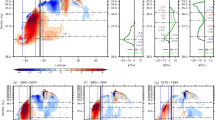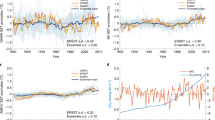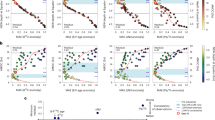Abstract
The factors driving glacial changes in ocean overturning circulation are not well understood. On the basis of a comparison of 20 climate variables over the past four glacial cycles, the SPECMAP project1 proposed that summer insolation at high northern latitudes (that is, Milankovitch forcing) drives the same sequence of ocean circulation and other climate responses over 100-kyr eccentricity cycles, 41-kyr obliquity cycles and 23-kyr precession cycles. SPECMAP analysed the circulation response at only a few sites in the Atlantic Ocean, however, and the phase of circulation response has been shown to vary by site and orbital band2. Here we test the SPECMAP hypothesis by measuring the phase of orbital responses in benthic δ13C (a proxy indicator of ocean nutrient content) at 24 sites throughout the Atlantic over the past 425 kyr. On the basis of δ13C responses at 3,000–4,010 m water depth, we find that maxima in Milankovitch forcing are associated with greater mid-depth overturning in the obliquity band but less overturning in the precession band. This suggests that Atlantic overturning is strongly sensitive to factors beyond ice volume and summer insolation at high northern latitudes. A better understanding of these processes could lead to improvements in model estimates of overturning rates, which range from a 40 per cent increase to a 40 per cent decrease at the Last Glacial Maximum3 and a 10–50 per cent decrease over the next 140 yr in response to projected increases in atmospheric CO2 (ref. 4).
This is a preview of subscription content, access via your institution
Access options
Subscribe to this journal
Receive 51 print issues and online access
$199.00 per year
only $3.90 per issue
Buy this article
- Purchase on Springer Link
- Instant access to full article PDF
Prices may be subject to local taxes which are calculated during checkout



Similar content being viewed by others
References
Imbrie, J. et al. On the structure and origin of major glaciation cycles. 1. Linear responses to Milankovitch forcing. Paleoceanography 7, 701–738 (1992)
Curry, W. B. in The South Atlantic: Past and Present Circulation (eds Wefer, G., Berger, W. H., Siedler, G. & Webb, D.) 577–598 (Springer, 1996)
Weber, S. L. et al. The modern and glacial overturning circulation in the Atlantic ocean in PMIP coupled model simulations. Clim. Past 3, 51–64 (2007)
Gregory, J. M. et al. A model intercomparison of changes in the Atlantic thermohaline circulation in response to increasing atmospheric CO2 concentration. Geophys. Res. Lett. 32 L12703 doi: 10.1029/2005GL023209 (2005)
McManus, J. F., Oppo, D. W., Keigwin, L. D., Cullen, J. L. & Bond, G. C. Thermohaline circulation and prolonged interglacial warmth in the North Atlantic. Quat. Res. 58, 17–21 (2002)
Boyle, E. A. & Keigwin, L. North Atlantic thermohaline circulation during the past 20,000 years linked to high-latitude surface temperature. Nature 330, 35–40 (1987)
McManus, J. F., Francois, R., Gherardi, J.-M., Keigwin, L. D. & Brown-Leger, S. Collapse and rapid resumption of Atlantic meridional circulation linked to deglacial climate changes. Nature 428, 834–837 (2004)
Dahl, K. A., Broccoli, A. J. & Stouffer, D. J. Assessing the role of North Atlantic freshwater forcing in millennial scale climate variability: A tropical Atlantic perspective. Clim. Dyn. 24, 325–346 (2005)
Curry, W. B. & Oppo, D. W. Glacial water mass geometry and the distribution of δ13C of ΣCO2 in the western Atlantic Ocean. Paleoceanography 20 PA1017 doi: 10.1029/2004PA001021 (2005)
Marchitto, T. M. & Broecker, W. S. Deep water mass geometry in the glacial Atlantic Ocean: A review of constraints from the paleonutrient proxy Cd/Ca. Geochem. Geophys. Geosyst. 7 Q12003 doi: 10.1029/2006GC001323 (2006)
Mackensen, A., Hubberton, H.-W., Bickert, T., Fischer, G. & Fütterer, D. K. The δ13C in benthic foraminiferal tests of Fontbotia Wuellerstorfi (Schwager) relative to the δ13C of dissolved inorganic carbon in Southern Ocean Deep Water: Implications for glacial ocean circulation models. Paleoceanography 8, 587–610 (1993)
McCave, I. N., Manighetti, B. & Beveridge, N. A. S. Circulation in the glacial North Atlantic inferred from grain-size measurements. Nature 374, 149–152 (1995)
Raymo, M. E., Ruddiman, W. F., Shackleton, N. J. & Oppo, D. W. Evolution of the Atlantic-Pacific δ13C gradients over the last 2.5 m.y. Earth Planet. Sci. Lett. 93, 353–368 (1990)
Lisiecki, L. E. & Raymo, M. E. A. Pliocene-Pleistocene stack of 57 globally distributed benthic δ18O records. Paleoceanography 20 PA1003 doi: 10.1029/2004PA001071 (2005)
Skinner, L. C. & Shackleton, N. J. An Atlantic lead over Pacific deep-water change across Termination I: Implications for the application of the marine isotope stage stratigraphy. Quat. Sci. Rev. 24, 571–580 (2005)
Ruddiman, W. F., Raymo, M. E., Martinson, D. G., Clement, B. M. & Backman, J. Pleistocene evolution: Northern hemisphere ice sheets and North Atlantic Ocean. Paleoceanography 4, 353–412 (1989)
Huybers, P., Gebbie, G. & Marchal, O. Can paleoceanographic tracers constrain meridional circulation rates? J. Phys. Oceanogr. 37, 394–407 (2007)
Ruhlemann, C., Mulitza, S., Muller, P. J., Wefer, G. & Zahn, R. Warming of the tropical Atlantic Ocean and slowdown of thermohaline circulation during the last deglaciation. Nature 402, 511–514 (1999)
Ruddiman, W. F. & McIntyre, A. Oceanic mechanisms for amplification of the 23,000-year ice-volume cycle. Science 212, 617–627 (1981)
Imbrie, J., McIntyre, A. & Mix, A. in Climate and Geo-Sciences (eds Berger, A. et al.) 121–164 (Kluwer Academic, 1989)
Schmidt, M. W., Vautravers, M. J. & Spero, H. J. Western Caribbean sea surface temperatures during the late Quaternary. Geochem. Geophys. Geosyst. 7 Q02P10 doi: 10.1029/2005GC000957 (2006)
Petit, J. R. et al. Climate and atmospheric history of the past 420,000 years from the Vostok ice core, Antarctica. Nature 399, 429–436 (1999)
Wang, Z. & Mysak, L. A. Simulation of the last glacial inception and rapid ice sheet growth in the McGill paleoclimate model. Geophys. Res. Lett. 29 doi: 10.1029/2002GL015120 (2002)
Khodri, M. et al. Modelling the climate evolution from the last interglacial to the start of the last glaciation: The role of Arctic Ocean freshwater budget. Geophys. Res. Lett. 30 1606 doi: 10.1029/2003GL017108 (2003)
Yoshimori, M., Weaver, A. J., Marshall, S. J. & Clarke, G. K. C. Glacial termination: Sensitivity to orbital and CO2 forcing in a coupled climate system model. Clim. Dyn. 17, 571–588 (2001)
Crucifix, M. & Loutre, M. F. Transient simulations over the last interglacial period (125–115 kyr BP): Feedback and forcing analysis. Clim. Dyn. 19, 417–433 (2002)
Tuenter, E., Weber, S. L., Hilgen, F. J., Lourens, L. J. & Ganopolski, A. Simulation of climate phase lags in response to precession and obliquity forcing and the role of vegetation. Clim. Dyn. 24, 279–295 (2005)
Shin, S., Liu, Z., Otto-Bliesner, B., Brady, E. & Kutzbach, J. Southern Ocean sea-ice control of the glacial North Atlantic thermohaline circulation. Geophys. Res. Lett. 30 doi: 10.1029/2002GL015513 (2003)
Kawamura, K. et al. Northern Hemisphere forcing of climatic cycles in Antarctica over the past 360,000 years. Nature 448, 912–917 (2007)
Huybers, P. Early Pleistocene glacial cycles and the integrated summer insolation forcing. Science 313, 508–511 (2006)
Acknowledgements
We thank T. Herbert, D. Oppo, Z. Liu, P. Huybers, A. Carlson and L. Robinson for discussions. L.E.L. was supported by the NOAA Postdoctoral Program in Climate and Global Change, administered by the University Corporation for Atmospheric Research. M.E.R. and W.B.C. acknowledge the support of NSF grants.
Author Contributions L.E.L. designed the study, performed the spectral analysis, and wrote the paper in consultation with M.E.R. and W.B.C.; contributed unpublished data from ODP Sites 926 and 928.
Author information
Authors and Affiliations
Corresponding author
Supplementary information
Supplementary Information
This file contains a Supplementary Discussion, Supplementary References Supplementary Tables 1-2 and Supplementary Figures 1-7 with Legends. (PDF 451 kb)
Rights and permissions
About this article
Cite this article
Lisiecki, L., Raymo, M. & Curry, W. Atlantic overturning responses to Late Pleistocene climate forcings. Nature 456, 85–88 (2008). https://doi.org/10.1038/nature07425
Received:
Accepted:
Issue Date:
DOI: https://doi.org/10.1038/nature07425
This article is cited by
-
No support for carbon storage of >1,000 GtC in northern peatlands
Nature Geoscience (2021)
-
Millennial-scale changes in atmospheric CO2 levels linked to the Southern Ocean carbon isotope gradient and dust flux
Nature Geoscience (2013)
-
The last glacial cycle: transient simulations with an AOGCM
Climate Dynamics (2012)
-
On the role of the Agulhas system in ocean circulation and climate
Nature (2011)
-
Synchronicity of Antarctic temperatures and local solar insolation on orbital timescales
Nature (2011)
Comments
By submitting a comment you agree to abide by our Terms and Community Guidelines. If you find something abusive or that does not comply with our terms or guidelines please flag it as inappropriate.



